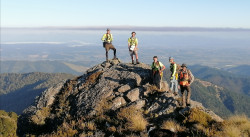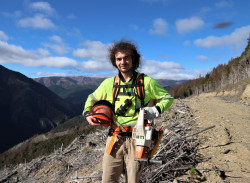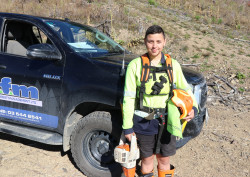The Wilding Conifer Control project under the Jobs For Nature programme successfully concluded on time and within budget, marking it as the first project to close under the programme. With its original funding ending in June 2024, ongoing funding is now managed under a new project outside the J4N programme.
Stay up to date with this long-term project as it progresses.
This year, we have continued our efforts in wilding conifer control in the Mt Richmond Management Unit, which has seen crucial control in some of the highest value conservation areas, specifically the ultramafic zones of the Red Hills (Maungakura) and ‘Red Hill’ in North Nelson.
Work was also carried out in key locations around the Management Unit, with a lot of control this year focused on the most troublesome wilding species Pinus contorta.
Great progress has been made in the area since late 2020 which has been further enhanced with operations undertaken by Nelson City Council and the Department of Conservation.
We are grateful for the support we have received from Central Government on this issue, particularly funding for the Jobs for Nature Programme.
We want to finish the job and maintain the gains we have made over the last few years. However, the National Wilding Conifer Control Programme, led by Biosecurity NZ/MPI, will see a reduction in funding that will markedly reduce the level of control operations after this year.
Under this scenario, less than half (42%) of the known national infestation would be actively managed, while spread and regrowth would continue in the abandoned management units.
Iwi, forestry, agriculture, conservation groups, regional and unitary councils, and Central Government agencies are actively collaborating to address this issue. Together, we are requesting that additional national funding of $15 million be provided annually, on top of the $10 million already budgeted per year for the next decade.
The requested investment level will enable us to safeguard our biodiversity, cultural values, water resources and productive lands, and reduce the risk of wildfires.
We are set to restart our schedule of wilding pine control operations for the 2022/23 season with our Jobs for Nature team undertaking drill and fill work and aerial work shortly.
Since 2020, we have teamed up with independent forestry management providers PF Olsen to conduct wilding pine control in the Mount Richmond Management Unit.
To date, close to 12,000 ha of the park have been surveyed or had wilding conifer control work carried out as part of the Ministry for Primary Industries (MPI) funded activities.
The first year of the project saw five full-time employees carry out 8,707 hours of groundwork, controlling wildings across 200 ha of the park.
The team also gained valuable skills in forestry and restoration work, while navigating often challenging terrain and multi-day excursions into the hills.
Jobs for Nature funding of $620,000 aims to cover 12,480 employment hours over three years.
We are also grateful for further funding of $729,524 for the Mount Richmond project in 2022/23, with $613k coming from MPI and the balance provided by the Department of Conservation.
We’ve also been pleased to support efforts to eradicate wilding conifers from sections of the Tākaka Hill by our partners Tākaka Hill Biodiversity Group Trust.
The Tākaka Hill project is independent from our work around Mount Richmond.
However, it is still an important part of wider eradication efforts and recent funding of $125,000 from MPI for 2022/23 will enable further control work on private and public conservation land within the Abel Tasman and Kahurangi National Parks.
Our work to eradicate Wilding Pine in our region has provided jobs and new outdoor experiences for those taking up the challenge, from helicopter drops to first-time mountain vista views.
Since 2020, we have teamed up with independent forestry management providers PF Olsen to conduct wilding pine control in the Mount Richmond Management Unit.
 The Mt Richmond Management Unit includes an ultramafic mineral belt which has unique geology, providing habitat for a number of taonga plant species found nowhere else in the country. These special plant species are currently at risk of being lost due to the invasive pine forest in the area.
The Mt Richmond Management Unit includes an ultramafic mineral belt which has unique geology, providing habitat for a number of taonga plant species found nowhere else in the country. These special plant species are currently at risk of being lost due to the invasive pine forest in the area.
The wilding conifer control work in this project will help to restore the specialised ecosystems on unique mineral-rich rock types.
Action Forest Management Limited has been engaged to deliver the ground control aspects of the project.
The project is funded by the National Wilding Conifer Control Programme, through Biosecurity New Zealand, as well as further funding through the Department of Conservation under the Jobs for Nature Programme.
In the 12 months to March 31 2022, the project has employed five full-time equivalent workers through DOC Jobs For Nature (J4N) funding, with many more employed across the wider project.
Since September 2021 the area treated by the J4N team alone is approximately 200Ha.
Among AFM’s hard working crew are Timaru’s Shay Young and Aiesha Tepuia from Blenheim.
Both responded to online ads in 2021 and, with the experience and skills gained on the job, have developed into highly valued members of AFM’s workforce within a matter of months.
 In March, Shay was part of a six-person crew that spent a week based at Starveall Hut undertaking Wilding Ground Control work, heli-lifted into the area along with their equipment and supplies.
In March, Shay was part of a six-person crew that spent a week based at Starveall Hut undertaking Wilding Ground Control work, heli-lifted into the area along with their equipment and supplies.
The crew completed an impressive 40 hectares of ground control (drill and fill) work over five days.
While Shay is used to hard manual work, being a city boy initially meant that working on hillsides or even tramping into the wilderness was unexplored territory.
A highlight of his Starveall excursion was a post-work walk to the 1500m summit of Mount Starveall one evening.
The quiet of the evening was broken as the rest of the crew at the hut heard Shay celebrating as he reached the top of the mountain.
“The Starveall week is probably the most enjoyable experience in my life. The helicopter flight in, then walking to the top of a mountain, staying there for four nights, and helping control the wildings in the great landscape of the area all made a really great week.”
Covid prevented Aiesha’s planned participation in the Starveall trip. However, heli-lifts have been just one of many experiences during her 14 months in the job.
Despite often rugged terrain and carrying 20kg on her back, Wilding Control work in the Hackett River and Motueka Gorge areas has been a natural fit, she says.
 Aiesha had previously undertaken physical work in deep sea fishing, farming and seafood processing, and a keen regional representative Women’s Rugby player.
Aiesha had previously undertaken physical work in deep sea fishing, farming and seafood processing, and a keen regional representative Women’s Rugby player.
“It’s great country up there and it’s good to get stuck into some of the big patches of big wilding trees as they will be causing lots of seed dispersal.”
The training opportunities provided have proved just as beneficial as the fitness gained from the long walk-ins. Both have undertaken First Aid Certification and Vegetation Fire Fighting exercises.
As a back up crew vehicle driver, Aiesha was also put through a 4 Wheel Drive Course.
AFM is currently on the lookout for anyone interested in joining the team for future Wilding Pine eradication plus exotic and native tree planting. Email [email protected].
Contractors returned to work in late October after a winter hiatus and expectations are high in making an impact on the biodiversity of some of our special natural areas.
In late 2020, we teamed up with independent forestry management providers PF Olsen, to start wilding conifer control in the Mount Richmond Forest Park Management Unit, which covers around 283,000 hectares across Te Tau Ihu on private, public and conservation land.
Despite the challenging terrain, the results since the start of the project have been encouraging and noticeable.
The crew have treated over 11,000 hectares of land affected by wilding conifer infestations, totalling around $1.45 million spent on control operations in 2020/2021.
Around 321 hectares have been treated with ground-based herbicide injection (drill and fill methods) and around 10,924 hectares with the aerial basal bark application method.
The four-year project is funded by the National Wilding Conifer Control Programme, through Biosecurity New Zealand, as well as further funding through the Department of Conservation under the Jobs for Nature Programme.
The project not only aims to remove wilding conifers from Mount Richmond Forest Park but also carry out further work to ensure they don’t return.
Project Manager George Daly said that the reality is the project is going to be a long term one in order to effectively control the large-scale infestation.
However, the collaboration undertaken between parties so far had proved beneficial in reducing the spread of wilding conifers, as well as providing local employment in the Covid-affected job market.
Have you seen blocks of trees turning brown in the hills around our region, particularly around the Hackett area, in recent months? It all points to employment opportunities and important conservation work in action.
Our involvement in the Mt. Richmond Wilding Conifer Control programme has made some good progress in the first few months as dedicated crews take on often-tricky back country terrain to protect the biodiversity of the management area.
We are leading the local project in conjunction with forestry management company PF Olsen, who have engaged Action Forest Management Limited to do ground control work.
The project has been funded by the National Wilding Conifer Control Programme through the Ministry for Primary Industries as well as funding from the Kaimahi for Nature Programme through the Department of Conservation.
Ground control work was identified as a priority for Kaimahi for Nature funding by the Kotahitanga mō te Taiao Alliance – a top of the South Island alliance of iwi, councils and Department of Conservation, that works collaboratively to enhance resilience in natural landscapes and communities across the region.
A total of $3.8 million will go towards eradicating wilding conifers in the Mt. Richmond Forest Park Management Unit – this encompasses both public and private land.
This will enable more ground teams to be used in preference to aerial spraying, improving results in parts of the park that are more accessible by foot.
The project will provide training and employment for workers over the next four years, as well as the potential for ongoing work in the native vegetation restoration field in other areas of Tasman District.
Our Wilding Conifer Control project manager George Daly said the funding had been hugely beneficial, not only in curbing the spread of the conifers’ seedbanks through the Richmond Ranges and beyond, but in providing local job opportunities.
Since beginning in December last year, around 9,300ha of land has been covered in and around the Forest Park.
The project is currently employing seven people and includes both helicopter herbicide application and ground control through a method called ‘drill and fill’.
Holes are drilled at 100mm intervals in the trees at a depth of at least 40mm and filled with an approved herbicide.
The trees are left standing and can take up to 18 months to die as they break down naturally and slowly dismantle back into the soil.
Manager of Action Forest Management Robin Thompson said there had been “some real success stories” amongst the personnel recruited, including the company’s first two female silviculture crew members and a number coming from outside forestry or conservation backgrounds.
Wilding Pine Ground Control work was winding down for the winter. However, the new recruits will assist with tree planting of over 600ha between July to September.
Once the annual season has been completed, some personnel may be selected as permanent employees.
Last modified: